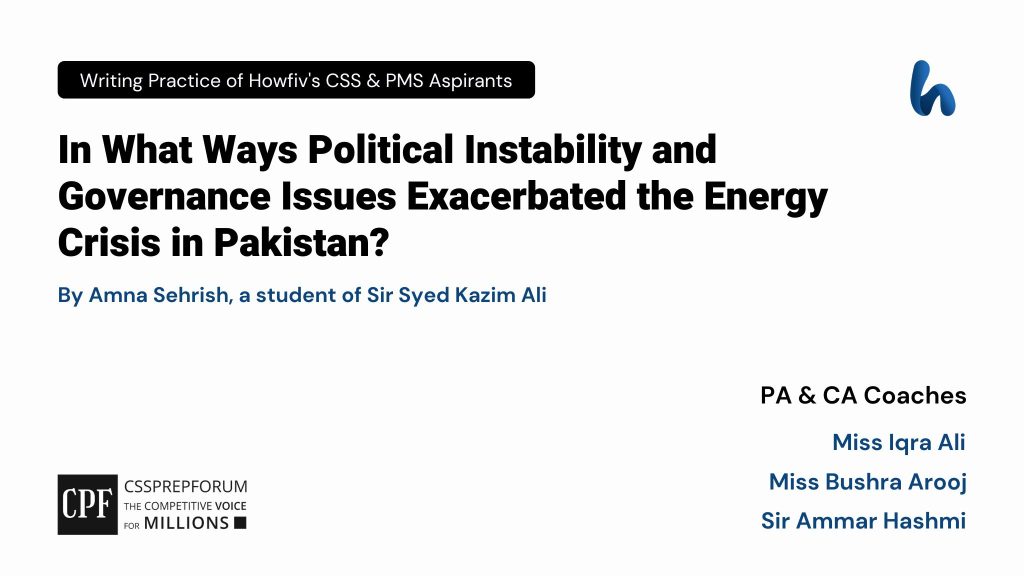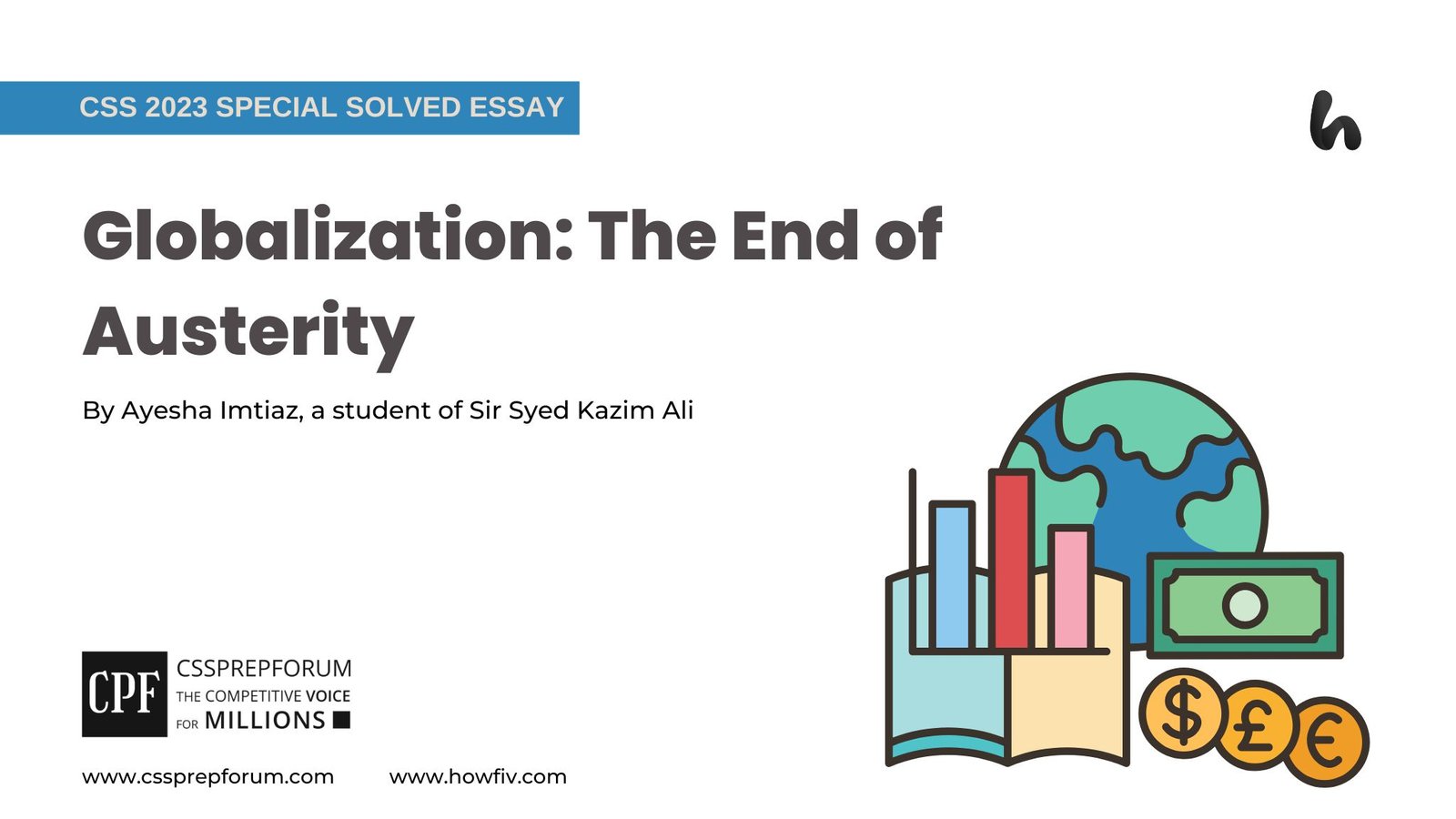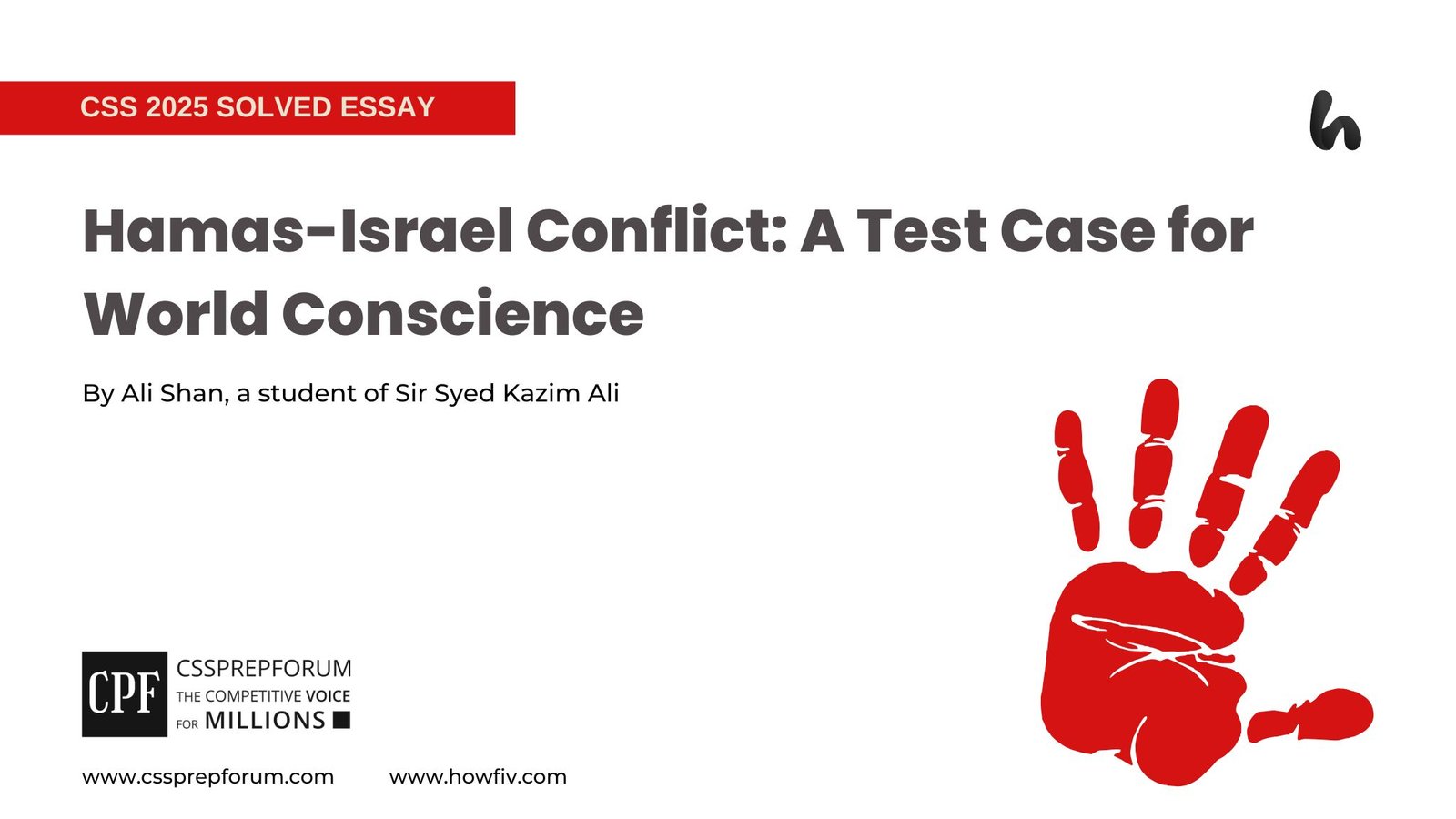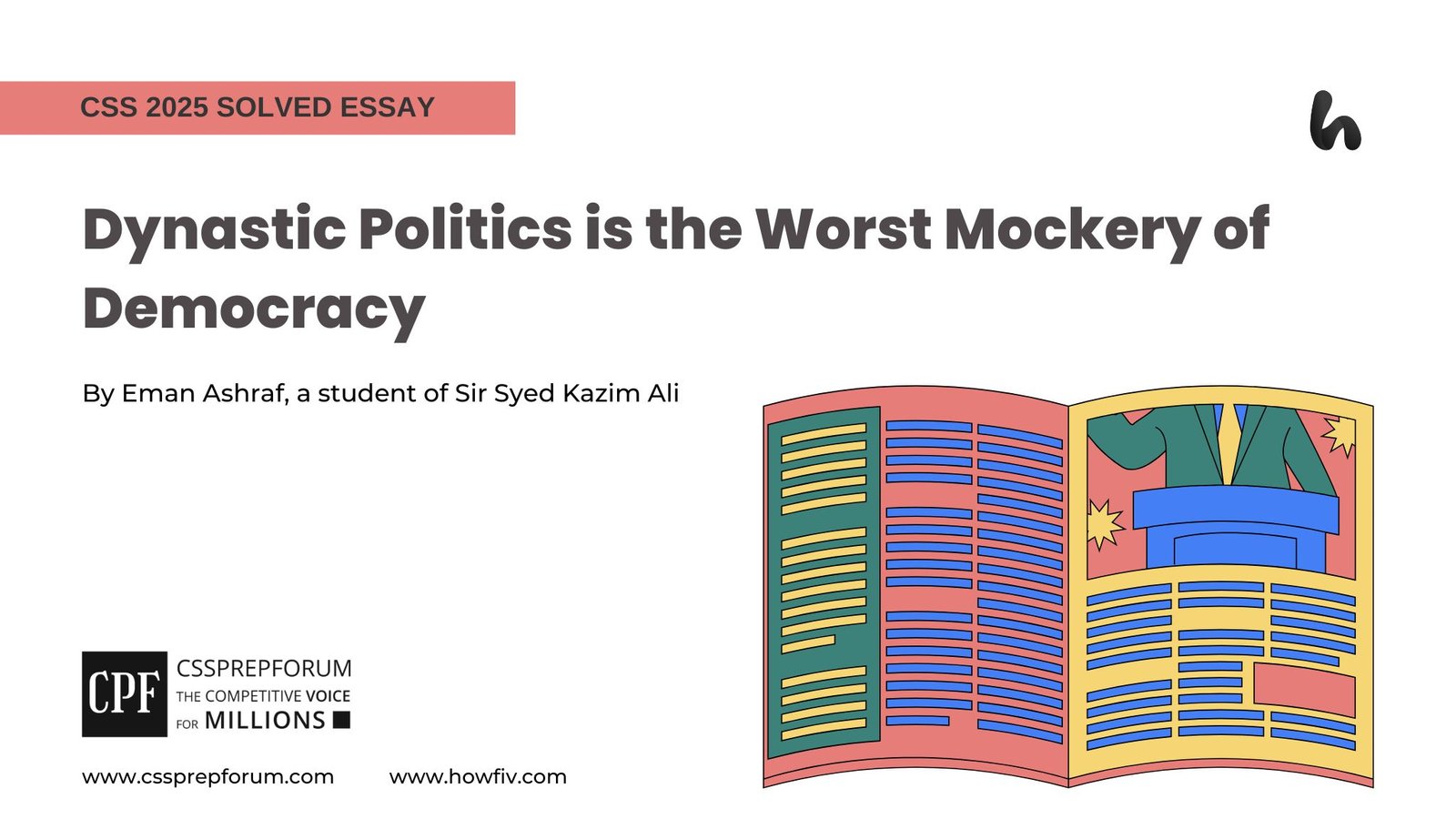CSS Current Affairs | Role of Political and Governance Issues in the Energy Crisis
The following question of CSS Current Affairs is solved by Amna Sehrish under the supervision of Howfiv’s Pakistan Affairs and Current Affairs Coaches. She learnt how to attempt 20 marks question and essay writing from Sir Syed Kazim Ali, Pakistan’s best CSS and PMS English essay and precis teacher with the highest success rate of his students. This solved past paper question is attempted on the pattern taught by Sir to his students, scoring the highest marks in compulsory and optional subjects for years, and uploaded to help aspirants understand how to crack a topic or question, how to write relevantly, what coherence is, and how to include and connect ideas, opinions, and suggestions to score the maximum.

Outline
1- Introduction
2- Critical overview of the energy crisis in Pakistan
- Case in point: According to the Institute of Strategic Studies Islamabad, the energy shortfall was 7000 megawatts in 2023 due to high demand.
3- Governance issues exacerbates the energy crisis
- ✓ Outdated infrastructure and transmission losses
- Case in point: transmission line losses account for 18% of the energy sector in Pakistan.
- ✓ Electricity theft and meter tampering
- Case in point: According to NEPRA, power theft is as high as 37.5% in some areas of Pakistan.
- ✓ Poor policies in energy sector
- Case in point: According to the World Bank Report 2020, Pakistan can meet its current power demand by utilizing only 0.071 per cent of its area for solar photovoltaics.
- ✓Outstanding payments
- Case in point: According to the performance evaluation report of LESCO 2023, outstanding payments stand at Rs 42.083 billion overall, out of which Rs 33.282 against the private sector alone.
- ✓ Irresponsible contracts with IPPs
- Case in point: In 2023, the federal government paid Rs 38.16 billion to IPPs without taking a single unit.
4- Political instability exacerbates the energy crisis
- ✓ Lack of trust among investors
- Case in point: According to the Political Stability Index 2021, Pakistan, with a score of -1.67, ranked 181 out of 194 countries.
- ✓ Corruption
- Case in point: According to the Corruption Perceptions Index 2023, Pakistan ranked 133rd among corrupt nations out of 180.
- ✓Uncompleted power projects
- Case in point: TAPI, IP gas pipeline, CASA 1000
- ✓Increasing circular debt
- Case in point: According to the Ministry of Energy of Power Division, circular debt was increased by Rs 84 billion in January 2024.
5- Suggestions to overcome governance-related issues in the energy sector
- ✓Transparency of budget allocation and funds in the power sector
- ✓privatization to improve the operational efficiency of the institute and recruitment of energy expert
- ✓political consensus on the immediate revival of power projects
6- Conclusion

Answer to the Question
Introduction
The energy crisis is a significant roadblock in the development of any country. Energy-insecure countries always lag behind the rest of the other developed countries in social growth and economic development. Pakistan, being no exception, stands among those countries dealing with the energy crisis for the past two decades. Aiming towards its causes, old infrastructure, absence of dams, illegal power connections, vast gap between demand and supply, lack of political consensus, and use of imported oil for power plants are among the primary culprits. Moreover, Pakistan’s dependence on fossil fuels for energy generation has worsened this situation. As a result, it has severely impacted the industrial, health, and agriculture sectors. The government must take serious and concrete steps in developing consensus on constructing new dams, using renewable energy, strictly monitoring power theft, and recovering overdue payments.
Critical overview of the energy crisis in Pakistan
Pakistan’s energy crisis has become a nightmare in recent years, with increasing circular debt, frequent government changes, high dependence on IPPs, transmission losses, and the absence of long-term policy. According to the Institute of Strategic Studies Islamabad, the energy shortfall was 7000 megawatts in 2023 due to high demand. The vast demand-supply gap widens in the peak summer months of June, July, and August.
Governance issues exacerbate the energy crisis
- ✓Outdated infrastructure and transmission losses
The government has not been severe in dealing with energy sector issues. Transmission line losses in Pakistan stand at 18%. Energy infrastructure is vulnerable to extreme weather conditions, leading to blackouts and load-shedding hours. To reduce distribution losses, old infrastructure should be replaced with a new and advanced system of transmission lines.
- ✓Electricity theft and meter tampering
In Pakistan, power theft, illegal connections, and meter manipulations are common practices in many areas, stressing the power sector. According to NEPRA, in some areas of Pakistan, power theft is as high as 37.5%.
- ✓Poor policies in energy sector
Frequent changes in governments and poor, short-term policy-making by every new government to win the voters’ sympathies have impacted the energy sector in the worst way possible. According to the World Bank Report 2020, Pakistan can meet its current power demand by utilizing only 0.071 per cent of its area for solar photovoltaics. Strategic policy for the use of renewable energy sources is inevitable.
- ✓ Outstanding payments
According to the performance evaluation report of LESCO 2023, outstanding payments stand at Rs 42.083 billion overall, of which Rs 33.282 are for the private sector alone. DISCOs’ lack of management skills and monitoring policy leads to huge receivables, further adding to circular debt.
- ✓ Irresponsible contracts with IPPs
In the 1990s, when the government of Pakistan allowed The Independent Power Procedure contracts, no foresight surgery was done. As a result of these poorly done agreements, the government had to pay capacity charges to private power companies even without utilizing a single unit from them. In 2023, the federal government spent around Rs 38.16 billion on IPPs without taking a single unit. The government made these payments received from the poor consumers in electricity bills.
Political instability exacerbates the energy crisis
Since its inception, Pakistan has been either under dictatorship or political instability. Political chaos and instability lead to poor policy implementation, weak management of state institutions, distrust between government and locals, increased circular debt and decreased foreign direct investment. The private sector also avoids investing in any industry. Political instability also halted power projects, such as TAPI and the Iran-Pakistan gas pipeline project, leading to economic and energy crises.
- ✓Lack of trust among investors
Political instability has also created mistrust among investors and stakeholders about investing such a hefty amount of money in the power sector. Investors don’t want to risk their investments in uncertain political scenarios, which has contributed mainly to the ongoing energy crisis in Pakistan. According to the Political Stability Index 2021, Pakistan, with a score of -1.67, ranked 181 out of 194 countries. The private sector avoids investing in power projects in uncertain political situations.
- ✓Corruption
Political instability also leads to corruption. Corruption in the power sector is not new in Pakistan. According to the Corruption Perceptions Index 2023, Pakistan ranked 133rd among 180 corrupt nations.
- ✓ Uncompleted power projects
Due to frequent regime changes, international projects such as TAPI, IP gas pipeline, and CASA 1000 projects have yet to be completed. Political stability would have allowed the completion of these projects on time, and thousands of megawatts of energy could have been added to the power sector.
- ✓ Short term policies
When there is political instability, every successive government has focused on short-term policies to gain quick outcomes so that at the next elections, they can use it for their election campaigns and voters’ sympathies. Pakistan’s energy sector is in dire need of long-term policies to get it out of a crisis state. Political chaos leads to inefficient and poor policy implementation.
- ✓ Increasing circular debt
Pakistan has been facing political instability since its inception. According to the Ministry of Energy of Power Division, circular debt increased by Rs 84 billion in January 2024. Political chaos also affects the supply of fuel, which further affects power plants and the distribution of power.
Suggestions to overcome governance-related issues in the energy sector
- ✓ Comprehensive and long-term strategies in the power sector and immediate shift to renewable energy sources to meet the consumer’s demand
- ✓ Transparency of budget allocation and funds in the power sector
- ✓Privatization to improve the operational efficiency of the institute and recruitment of energy experts
- ✓Political consensus on the immediate revival of TAPI, Peace Pipeline, CASA 1000 power projects and construction of new dams.
Conclusion
The energy crisis is a significant roadblock in Pakistan’s economic progress. The government can take extreme measures to overcome the challenges in the energy sector. An immediate shift to renewable energy sources in the public and private sectors can be a breath of fresh air for the sector. The government can save billions of rupees by revisiting agreements with IPPs. Privatization of the energy sector can be a major step in curbing the energy crisis. Simply, political will and comprehensive long-term strategies in the power sector can be fruitful for Pakistan.

CSS Solved Past Papers’ Essays
Looking for the last ten years of CSS and PMS Solved Essays and want to know how Sir Kazim’s students write and score the highest marks in the essays’ papers? Then, click on the CSS Solved Essays to start reading them.
CSS Solved Essays
CSS Solved Islamiyat Past Papers
Want to read the last ten years’ Islamiyat Solved Past Papers to learn how to attempt them and to score high? Let’s click on the link below to read them all freely. All past papers have been solved by Pakistan’s top CSS Islamiyat coach having the highest score of their students.
CSS Solved Islamiyat
CSS Solved General Science & Ability Past Papers
Want to read the last ten years’ General Science & Ability Solved Past Papers to learn how to attempt them and to score high? Let’s click on the link below to read them all freely. All past papers have been solved by Pakistan’s top CSS GSA coach having the highest score of their students.
CSS Solved General Science & Ability











